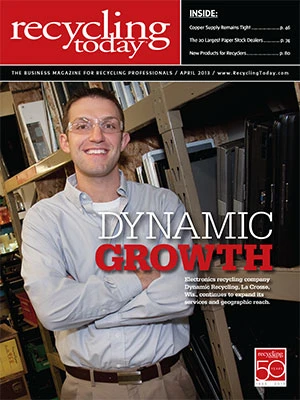
As the first quarter of the year draws to an end, it appears prices for most primary and secondary nonferrous metals are turning downward in response to less-than-encouraging economic reports from China and Western Europe.
The negative news appears to be overriding a moderately upbeat U.S. economic outlook.
The pessimistic tone replaces a more bullish outlook expressed by many scrap metal recyclers earlier this year. At that time, scrap metal dealers said they felt that after China’s Lunar New Year holiday concluded, buyers for Chinese consumers would return to the market.
The earlier optimism also was fueled by a feeling that China’s incoming administration would inject significant capital into the economy, which would result in a spurt of infrastructure investments. The net result would be a boost for many base metals, including a range of nonferrous grades.
With this in mind, some nonferrous scrap exporters had been going after more scrap supplies to capitalize on a resurgent China market.
While the Chinese government could still spur infrastructure investments, boosting metals prices, a number of factors could keep downward pressure on primary and scrap metals.
According to a Reuters report, China’s State Reserves Bureau purchased 300,000 metric tons of aluminum and 45,000 metric tons of zinc in the middle of March. The move, according to several sources, is an attempt to halt the slide in finished aluminum prices, which have fallen to a multiyear low, as well as to stabilize zinc prices, which have fallen to the lowest level since late 2012.
Despite these purchases, multiple sources report that a significant percentage of the aluminum smelters throughout the world are operating at a loss, including a large percentage of Chinese aluminum smelters. More capacity may be removed from the market during the next several quarters in response.
Oleg Deripaska, the CEO of Moscow-based Rusal, the world’s largest aluminum company, recently said global commodity producers needed to cut output by up to 10 percent to bring the market back into balance. In fact, earlier this month Rusal announced plans to cut its aluminum output by 300,000 metric tons by the end of 2013.
During the recently concluded Middle East Metals Recycling Conference, Regina Crespo with St. Louis-based Metals Exchange, provided an outlook for aluminum markets. In her presentation, she said that going forward, North America and Europe would face the challenge of keeping available aluminum scrap in their domestic markets. These buyers would be confronted with strong demand from China and other emerging markets, she said. However, Crespo added, “China will still grow and play a dominant role in the industry, but the big boom is over.”
Regarding copper, a Reuters report notes that prices on the London Metal Exchange (LME) posted a 4 percent decline in February, squelching what some felt would be a rally earlier in the year. According to one report, the lack of growth in Europe, along with uncertain economic conditions in other regions, could result in an oversupply of copper through 2013.

Explore the April 2013 Issue
Check out more from this issue and find your next story to read.
Latest from Recycling Today
- Fenix Parts acquires Assured Auto Parts
- PTR appoints new VP of independent hauler sales
- Updated: Grede to close Alabama foundry
- Leadpoint VP of recycling retires
- Study looks at potential impact of chemical recycling on global plastic pollution
- Foreign Pollution Fee Act addresses unfair trade practices of nonmarket economies
- GFL opens new MRF in Edmonton, Alberta
- MTM Critical Metals secures supply agreement with Dynamic Lifecycle Innovations







